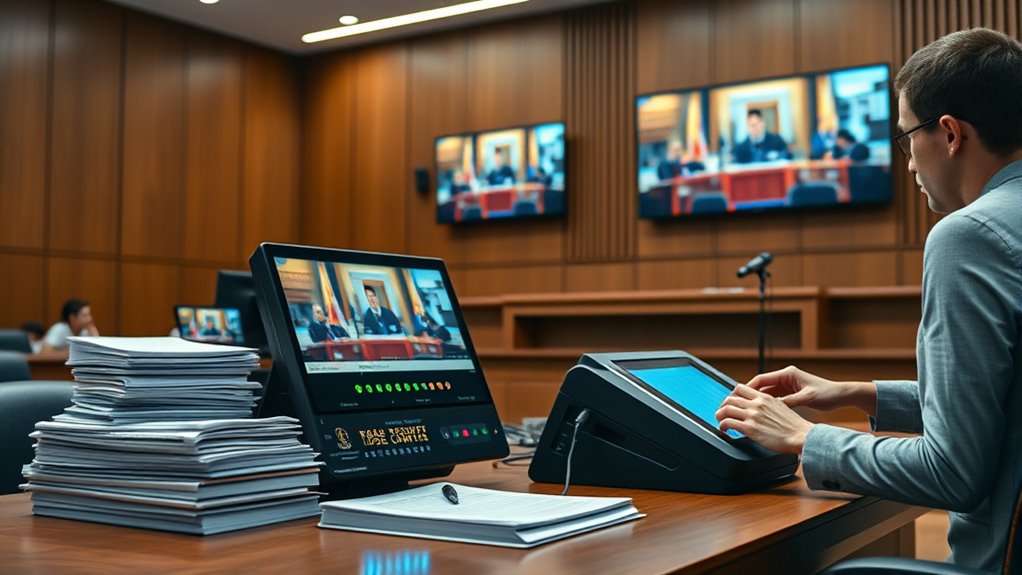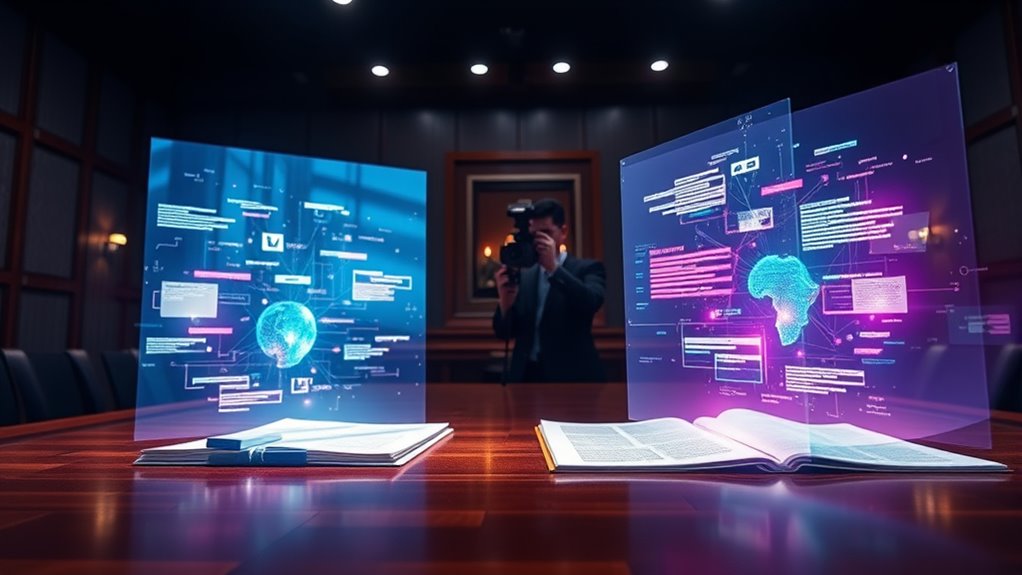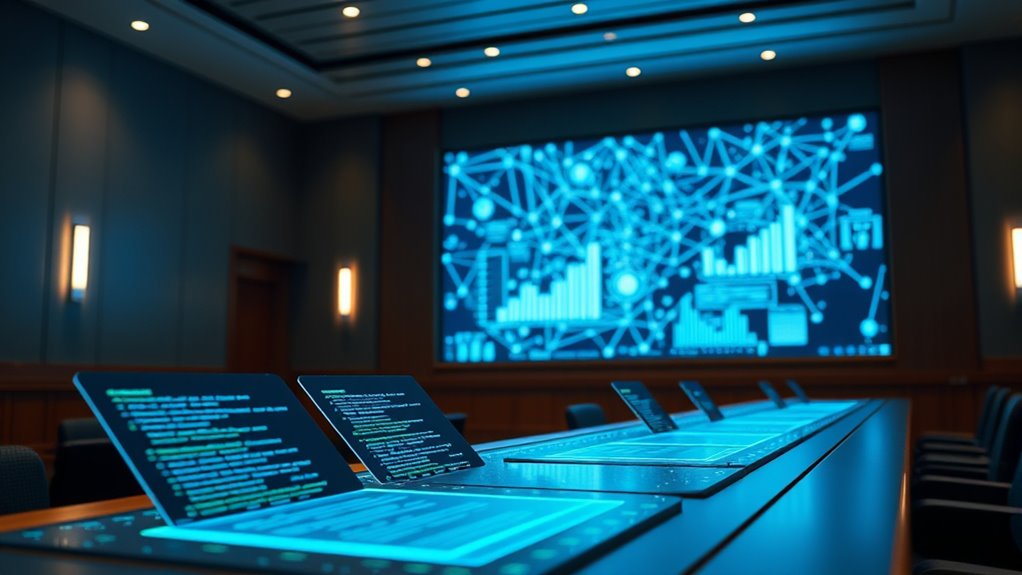AI and digitisation are transforming court transcripts by enabling fast, accurate, and cost-effective transcription of legal proceedings. They automate tasks, improve efficiency, and make records more accessible, often addressing workforce shortages and regulatory demands. While AI enhances reliability, human oversight remains essential for accuracy and security. This evolution supports virtual hearings and ensures transparency. If you’re curious about how these innovations impact justice systems, there’s much more to explore.
Key Takeaways
- AI accelerates court transcript generation, reducing turnaround times from weeks to hours.
- Digitisation ensures secure, searchable, and easily retrievable legal records for efficient case management.
- Combining AI with human oversight enhances transcription accuracy and reliability in legal proceedings.
- Regulatory drivers and workforce shortages promote adoption of AI-driven digital court reporting solutions.
- Ensuring data security, ethical standards, and quality assurance is crucial for effective AI implementation.
The Rise of AI-Powered Court Reporting Technologies

The rise of AI-powered court reporting technologies is transforming the legal landscape by making transcription faster, more cost-effective, and widely accessible. You can now get transcripts generated in hours instead of weeks, often at half the traditional cost. AI combined with human oversight ensures quicker turnaround times while maintaining accuracy. Automated systems operate around the clock, allowing courts to record proceedings anytime without delays. This technology also lowers barriers for new court reporters, speeding up certification and expanding the workforce. Remote digital reporting means you no longer need to worry about travel or scheduling conflicts, increasing flexibility in court coverage. Understanding self watering plant pots can offer insights into how automated systems maintain consistent moisture levels, akin to AI systems maintaining accuracy. Additionally, the integration of vetted transcription tools ensures high-quality results that meet legal standards. The adoption of digital platforms further streamlines the process by enabling real-time editing and review, which enhances overall efficiency. Moreover, implementing quality control measures similar to those in juice cleansing—such as regular checks for accuracy—helps ensure reliable transcripts. Overall, AI-driven tools are reshaping how legal transcripts are produced, making the process more efficient and accessible than ever before.
Overcoming Workforce Shortages Through Digital Solutions

AI-powered digital solutions are revolutionizing how courts address persistent workforce shortages among court reporters. By automating transcription tasks, you can reduce reliance on a limited pool of stenographers, easing staffing pressures. These tools lower certification barriers and speed up training, allowing more individuals to become qualified quickly. Remote digital reporting expands access in underserved areas, ensuring courts can cover cases without always relying on local stenographers. Automated systems operate around the clock, providing continuous coverage and faster transcript delivery, which helps meet increasing demand. Hybrid models combining AI with human oversight maintain quality while reducing workload. Additionally, advancements in on-device AI capabilities like those in Qualcomm’s Snapdragon 8 Gen 3 support real-time language translation and image recognition, further enhancing the accuracy and efficiency of digital court reporting. Incorporating organic and natural juices into wellness initiatives can also improve staff well-being and productivity, supporting a healthier workforce. Furthermore, understanding the retirement planning options available can help court staff prepare financially for the future, ensuring a more stable and focused workforce. Exploring training programs can also facilitate the rapid upskilling of personnel to adapt to new digital workflows. As AI technology continues to evolve, its integration into judicial processes promises even greater improvements in efficiency and accessibility. Overall, these digital solutions help you overcome staffing gaps, improve efficiency, and ensure courts keep pace with growing caseloads despite workforce limitations.
Enhancing Accuracy and Reliability in Legal Transcriptions

You need to understand that while AI has improved transcription accuracy, it still isn’t perfect. Human oversight is crucial to catch errors and guarantee transcripts meet the high standards required in legal settings. Combining AI with expert review is the best way to enhance both precision and reliability in court transcripts. Incorporating active listening and empathy during review processes can further ensure that nuanced details are accurately captured and understood. Additionally, fostering a creative practice in review teams can lead to more innovative approaches to resolving complex transcription challenges. Recognizing the importance of mental clarity and health among transcription professionals can improve focus and overall accuracy during the review process. Furthermore, understanding the vulnerabilities in AI models underlines the need for rigorous oversight to maintain trustworthiness and security in legal transcriptions. Awareness of industry standards can also guide the development and implementation of more effective transcription practices.
Improving Transcription Precision
Enhancing transcription precision in legal settings requires combining advanced AI algorithms with targeted human oversight. You should select AI systems trained on extensive legal vocabulary and context-specific data to improve initial accuracy. Regularly update and fine-tune algorithms with new case examples to adapt to evolving language and terminology. Implement calibration processes that identify common errors and adjust outputs accordingly. Incorporate language models that recognize legal jargon, speaker identification, and context nuances to reduce misinterpretations. Using high-quality audio, minimizing background noise, and ensuring clear recordings also boost AI performance. Additionally, implementing quality assurance protocols can help detect and correct errors before finalizing transcripts. Incorporating feedback from legal professionals can further refine AI outputs and ensure compliance with legal standards. The integration of automated transcription tools can significantly speed up the process while maintaining accuracy. It is also essential to stay informed about recent cybersecurity threats that could compromise sensitive case data, emphasizing the importance of cybersecurity awareness in legal transcription workflows. Ultimately, pairing these technological improvements with expert review guarantees transcripts meet the high standards of legal accuracy, making them reliable for courtroom use. Louisiana Civil Code provides legal guidelines that inform the standards for documentation and transcript fidelity in legal proceedings.
Human Oversight Necessity
While AI transcription systems have made significant progress, they cannot yet match the nuanced understanding and contextual awareness of human court reporters. You need human oversight to catch errors, guarantee accuracy, and interpret subtle courtroom cues that AI may miss. AI can produce transcripts quickly, but its mistakes—like hallucinations or misheard words—still require review. Human reporters verify the AI’s work, maintaining legal standards and ensuring transcripts meet strict accuracy benchmarks. They also handle complex legal terminology and emotional context, which AI struggles to grasp reliably. Without human oversight, transcripts risk inaccuracies that could undermine legal proceedings. Additionally, natural language understanding is crucial in legal transcription because it involves interpreting complex legal language and context that AI may not fully comprehend. Furthermore, diverse genres like action, romance, and fantasy in media emphasize the importance of nuanced interpretation, which human oversight ensures in legal transcription. Accordingly, combining AI efficiency with human judgment creates a more dependable, trustworthy process—vital for preserving the integrity and reliability of court records.
Practical Applications of AI in Courtroom Proceedings

You can leverage AI to speed up transcription processes, making transcripts available within hours instead of weeks. It also helps manage case documents more efficiently by sorting, categorizing, and extracting key information. Additionally, AI tools can quickly summarize lengthy depositions and analyze legal files, streamlining courtroom workflows and decision-making.
Accelerated Transcription Processes
AI markedly accelerates court transcription processes by providing real-time or near-instantaneous conversion of spoken words into written transcripts. This rapid turnaround reduces delays, enabling legal teams to review proceedings promptly. Combining AI with human oversight ensures transcripts are delivered within hours or days, instead of weeks, streamlining case management. Automated transcription services operate around the clock, increasing availability and eliminating bottlenecks caused by traditional stenography. AI-powered tools also enable remote reporting, saving travel time and expanding access to courts in underserved areas. By automating initial transcription steps, AI helps courts handle increasing caseloads efficiently. As a result, legal professionals gain faster access to accurate transcripts, allowing for swifter case preparation and improved judicial efficiency.
Case Document Management
Effective case document management is essential for streamlining court proceedings and reducing delays. AI tools help you organize, categorize, and retrieve documents quickly, ensuring you access critical files when needed. Automated indexing and tagging allow for faster searches, minimizing time spent on manual sorting. AI-powered systems can also detect inconsistencies or duplicates, maintaining document integrity. With digital management, you can securely store and back up case files, reducing the risk of loss or tampering. Remote access enabled by AI allows authorized users to review documents from anywhere, supporting virtual hearings and collaboration. This streamlined approach not only accelerates case handling but also enhances accuracy and security, helping courts meet increasing demands while maintaining high standards of legal compliance.
Summarization and Analysis
Summarization and analysis tools powered by AI are transforming courtroom proceedings by enabling legal professionals to quickly extract key information from vast amounts of transcript and document data. These tools automatically identify relevant facts, timelines, and legal arguments, saving you hours of manual review. AI-generated summaries condense lengthy depositions, court opinions, and filings into concise overviews, making case preparation more efficient. You can also analyze patterns, identify inconsistencies, and detect potential issues across large datasets. This enhances your ability to assess case strengths and weaknesses rapidly. While AI improves speed and insight, it still requires human oversight to guarantee accuracy and context. Implementing these tools helps streamline workflows, reduces errors, and allows you to focus on strategic legal work.
Regulatory Changes Accelerating Digital Transcription Adoption

Regulatory changes are rapidly driving the adoption of digital transcription methods in court systems worldwide. You’ll notice governments and judicial bodies implementing laws that mandate electronic case management and digital recordkeeping, pushing courts to modernize. For example, the EU’s requirement for electronic file management by 2026 compels courts to adopt AI-driven transcription tools. Courts are also facing increased pressure to meet accuracy standards, often requiring transcripts to reach 99.5%, which encourages the integration of AI with human oversight. Certification organizations now set strict quality benchmarks for digital court reporters, ensuring reliability. Additionally, contractual regulations demand high-performance AI systems, further accelerating adoption. These regulatory shifts create a framework that promotes efficiency, transparency, and accessibility, making digital transcription an essential component of modern judicial processes.
Addressing Challenges and Risks of AI in Legal Documentation

While AI offers promising solutions for legal documentation, it also introduces significant challenges and risks that cannot be overlooked. You must consider the potential for inaccuracies, such as hallucinations or misinterpretations, which could compromise case integrity. AI lacks the ability to certify transcripts or authenticate their legal admissibility, raising questions about reliability. Security is another concern; sensitive data processed offshore or without proper protections could be vulnerable to breaches. Human oversight remains essential to catch nuances, emotional context, and ensure high accuracy. Additionally, legal standards demand near-perfect transcripts—something AI alone cannot guarantee. Balancing efficiency gains with the need for trust, transparency, and compliance requires careful integration of AI tools alongside qualified human reviewers.
The Future of Court Transcripts: Integration and Innovation

The integration of AI into court transcription systems is poised to revolutionize the judicial process, combining technological innovation with existing legal standards. You’ll see smarter workflows, faster turnaround times, and expanded access to justice. Innovation isn’t just about replacing old methods but enhancing them with reliable, scalable solutions.
- AI-powered systems will enable seamless integration with case management platforms, improving data flow and reducing manual input.
- Continuous updates and machine learning will refine transcription accuracy, moving closer to legal standards of 99.5%.
- Collaboration between AI and human oversight will foster trust, ensuring transcripts meet legal, ethical, and privacy requirements.
This future balances speed, efficiency, and reliability, transforming court reporting into a more dynamic, accessible process.
Balancing Efficiency With Legal Standards and Trust

Balancing efficiency with legal standards and trust requires careful integration of AI into court transcription processes. You must ensure AI tools meet strict accuracy and reliability benchmarks while maintaining transparency. Human oversight remains essential to catch errors and validate transcripts, safeguarding legal integrity. To illustrate, consider the following:
| Aspect | Consideration |
|---|---|
| Accuracy | AI must achieve near-perfect transcription, with human review ensuring 99.5% standards. |
| Certification | Transcripts need official validation; AI alone can’t certify authenticity. |
| Privacy | Sensitive data requires robust protections, especially when processed offshore. |
| Transparency | Clear processes are necessary for accountability and trust. |
| Oversight | Human judgment remains crucial for nuance, context, and legal admissibility. |
This balance preserves trust in courts while harnessing AI’s efficiency.
Frequently Asked Questions
How Do AI Court Transcripts Handle Multiple Speakers and Accents?
You’ll find that AI court transcripts handle multiple speakers and accents by using advanced speaker diarization and speech recognition algorithms. These tools differentiate speakers based on voice patterns and context, even with diverse accents. However, accuracy can vary, especially with heavy accents or overlapping speech. To guarantee reliability, human review remains essential, as AI may misidentify speakers or struggle with nuanced pronunciation, requiring oversight to meet legal standards.
What Are the Legal Implications of Using Ai-Generated Transcripts?
Using AI-generated transcripts carries significant legal implications. You must verify their accuracy and reliability, as courts demand near-perfect records, often 99.5% precision. You’re responsible for verifying transcripts through human review, especially since AI can produce errors or hallucinations. Additionally, safeguarding data privacy and maintaining chain-of-custody are vital. If transcripts aren’t properly certified or authenticated, they might be challenged in court, risking legal validity and affecting case outcomes.
How Is Data Privacy Maintained With Offshore Transcription Services?
Think of your data as a precious treasure. When you use offshore transcription services, you entrust that treasure to a distant lighthouse. To keep it safe, you make sure they follow strict security protocols, like encryption and compliance with data protection laws. Regular audits act as vigilant guards, and clear agreements set boundaries. These steps protect your sensitive information, so your treasure remains secure, no matter how far it travels across the sea.
Can AI Transcripts Be Used as Legally Binding Evidence in Court?
AI transcripts alone can’t be used as legally binding evidence in court yet. You need human oversight to verify accuracy and authenticity, especially since AI can produce errors or hallucinations. Courts require transcripts to meet strict standards and often demand certification by qualified professionals. While AI speeds up transcription, you’ll still rely on certified human reviewers to guarantee the transcript’s legal validity and admissibility in court proceedings.
What Training Is Required for Human Oversight of AI Court Reporting Tools?
You’ll need training that makes you a digital detective, skilled in spotting AI’s quirks and errors. Expect to learn legal terminology, transcription standards, and how to review and verify AI-generated transcripts efficiently. You’ll also need to understand data privacy, security protocols, and ethical considerations. Fundamentally, you become the gatekeeper, ensuring the AI’s work meets legal standards while maintaining the courtroom’s trust—because even robots need a good watchdog.
Conclusion
As you explore AI and digital court transcripts, remember that over 70% of legal professionals now see AI as essential for efficiency. By embracing these technologies, you can boost accuracy, save time, and overcome staffing shortages. While challenges exist, ongoing innovations promise better integration and trust. Staying informed and adaptable will guarantee you benefit from the future of court reporting, making legal processes more reliable and accessible for everyone.








